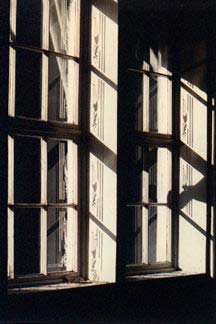 Lighting Is All About Chiaroscuro
Lighting Is All About Chiaroscuro
by Walter Graff
NOTE: Your computer monitor is not a TV set. The gamma
settings of your computer monitor are usually different
than a TV set, hence some of the photos may look dark
or not as good as they should. Use these photos only as
a reference.
Ask anyone what the single most important advancement in the area of film and video production is today and you'll hear such words as 'non-linear', high definition, and 'digital'. But if you were to ask me that same question I'd say the single most advancement in production today is still the understanding of chiaroscuro. I'll explain...
Technological advances in the last ten years have offered a myriad of formats and cameras for today's production community and changed the way we produce film and video. Regardless of pixel count, horizontal resolution, grain structure or format, creating a good picture still comes down to techniques that were developed five hundred years ago. Without chiaroscuro, digital is just a bunch of squares, non-linear is non existent and HD might as well be DV. Now more than ever, chiaroscuro plays an important part in any production. What? You never heard of chiaroscuro? Perhaps you never used the term, but if you've ever stuck a lighting fixture into the stud of a light stand or sat through years of art history class as I did, then you ought to know it. It's the element that helped make Marlene Dietrich a star, made The Godfather' a household name, inspired the term 'noir', and gave 'Citizen Cane' the title of number one movie of all time.
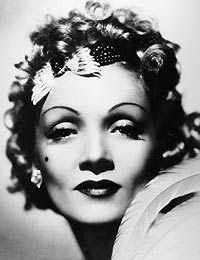
Marlene Dietrich
-If it wasn't for light and shade would she look as good as she does here?
So what exactly am I talking about? I'm referring to the technique that made the late Italian Renaissance and Baroque periods so wonderful; the same technique that we use today to create a three-dimensional palette in the two dimensional world of film and TV. Chiaroscuro (pronounced- kee-ahr'oh-scyoo"roh) is Italian for 'light and shade' (clear, light + oscuro, obscure/dark). Chiaroscuro represents the shadow and light we use in lighting everything from a box of Wheaties to actors in a romantic dinner setting. It's what gives our pictures depth and what gives your story emotion. While history writes that one of the first to use this technique was Duccio di Buonisegna in the "Rucellai Madonna" in the 1200's, to me the father of Chiaroscuro, the person who took it to a new dimension is a painter named Michelangelo Merisi known more famously as Caravaggio. Actually, I might go as far as to say that Caravaggio was the first director of photography. Prior to Caravaggio most folks painted images of saints and God's from perceptions in their heads. How else could they? You couldn't ask God to sit for an hour now could you? Caravaggio found a new way to paint saints and deities. He hired actors (usually the vagrants of the time who lived in his neighborhood) to play the parts of the people represented in his paintings. He had folks sit for him in often uniquely lit rooms and based his paintings on the light and shadow he saw. So in a way, he was putting actors in specific lighting set-ups and (if you stretched your imagination a bit) could be considered the first Director of Photography. Of course at the time he was condemned for using mere mortals (and the poor at that) as representing Gods.

One can look at films like The Godfather and see how much they really look like paintings of old.
So lets jump ahead 500 years.
Look at the photo above taken from the movie "The Godfather".
If I asked you to tell me about Don Corleone, the famous character that was the Godfather, you'd probably use terms such as mysterious and powerful to describe the character. What did you base your response on? Of course you based it on the script from the film that made him into the character he was. But was it just the script? If his office was bright yellow in color, and lit with fluorescent lighting fixtures, would we still have called him mysterious? Could the script have made him such a strong figure without the right atmosphere to convey that attitude? Well his office wasn't bright yellow thankfully, and the lighting was dim and moody. The point is that as artists we have incredible power in defining a scene with lighting. Movies such as 'The Godfather' show how powerful light and shadow can be. In fact take a look at the AFI's top ten list of films ever made:
1. CITIZEN KANE (1941)
2. CASABLANCA (1942)
3. THE GODFATHER (1972)
4. GONE WITH THE WIND (1939)
5. LAWRENCE OF ARABIA (1962)
6. THE WIZARD OF OZ (1939)
7. THE GRADUATE (1967)
8. ON THE WATERFRONT (1954)
9. SCHINDLER'S LIST (1993)
10. SINGIN' IN THE RAIN (1952)
Take stills from each and you would have a museum display no less in quality than a showing of Renaissance painters. I think without chiaroscuro, those films might not be as memorable.


L. Singing In the Rain
R. The Wizard of Oz

 L. The Graduate
L. The Graduate
R. On The Waterfront
Since the Renaissance, where artist discovered how to use oils to create shadow and light, the inanimate world has never been the same. Look at the following pictures:
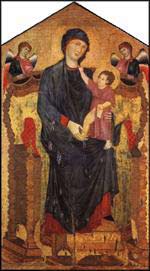
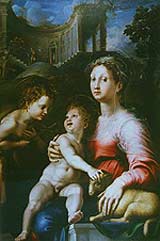
On the left is a portrait of the Madonna by Medieval Italian painter Cimabue. On the right is The Madonna and Child with Saint John the Baptist by Giulio Romano. See any difference? What happened once artists began to see shadow and light as the painting on the right does? The painting on the right looks more like a photo. Using shadow and light, Romano was able to create three dimensions on a two-dimensional canvas. In fact Romano, like others of his time brought paintings to life. Today that same technique is no longer confined to canvas, but is used in the mediums of film and video that we create today. Are they really any different than the techniques of the painters of Carvaggio's day? I say it's all about light and shadow and the best way to learn how to light is to simply look around you. I know I can't light a scene without having an idea of what that scene should look like before I plug in a fixture. When someone tells me to make a bedroom look mysterious, I draw on pictures in my mind of what I have seen, or lived. Sometimes I run home and rent a dozen films that have similar scenes to see what I like. It's all about looking at life and cataloging what you see so you can draw on it later on. I know my years of still photography have given me a much better ability at capturing a moment so I can recreate it. And so has a visit to The Metropolitan Museum of Art. You ought to try visiting a museum one day. Not only will you see great paintings, but just being there in the natural light, looking at the people might inspire you. I am really bad at crossword puzzles. But I know people that are very good at them. That's because they do crossword puzzles all the time. They practice. I practice looking at light so I'm good at light. If you want to get better at lighting you need to practice.
Also consider this, just because you have eyes doesn't mean you see everything. Consider the time before the late Renaissance and Baroque periods when paintings looked like flat images on canvas. One day someone looked at the canvas differently adding shadow and picked a light source and from that day on the world of art changed forever. But for centuries before that time folks never saw this. It's not that they couldn't see it, rather that they just never made the connection. As an artist, I too don't always see everything in front of me. This is why it's always important to view the work of others to see what you might be missing.


So what is the difference between the two images above in terms of capturing human form? Of course they are not identical, but the theme is similar. Notice a single source of light and shadow which results from the fall-off in both. Notice how the light strikes Jesus in the painting on the left and the similarity to how the light strikes The Godfather still on the right. It's almost as if Gordon Willis (cinematographer from The Godfather) spent the day in a museum before shooting the film. While he probably wasn't trying to copy the artists like Carvaggio (maybe he was?), he certainly used the tool of chiaroscuro well. Both pictures are lit from what appears to be a large strong source from high above.
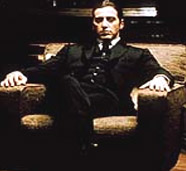
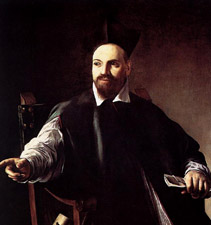
See any similarity in the photos from above?
Pacino in a chair some five hundred years after the painting on the right, yet both eerily similar in lighting. I guess not much has really changed!

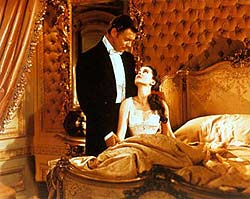
And what is the difference in the two photos above other than the fact that "Gone with the Wind" is rated G and the painting on the left, if it was a motion picture, would probably get an R rating or worse? The similarity in both is not only color usage but light and shadow. In fact the entire movie is like a million paintings all photographed to create motion. Both scenes are lit from a low, strong source.
A lot of people email me asking what books are available for learning more about lighting. I say, no books can teach you about art, only the mechanics. Can you say you know how to drive a car by saying you read a driving manual? I tell them to spend a day down at their local museum and see where it all began. It's inspiring and should be the basis for all courses on cinematography as far as I am concerned.
Even better, just look around you. It's all around you right now. All you have to learn to do is how to see it, and repeat it, not unlike a painter who sets up a canvas and copies what he sees. Technology sure has come a long way, but technique is many generations old. In other words technology can not make a better artist. That part you have to learn. So next time you see one of these long threads on a cinematography board talking about pixels and how $5k cameras look just like $100k cameras, remember you are not reading a thread about the technique of filmmaking, only about the hammers used to hit nails into wood.
Copyright 2013 by Walter Graff. This article may be circulated and shared as long as the following reference is made: 'This article appears courtesy of Walter Graff- http://www.waltergraff.com'
Please don't hesitate to send me an e-mail if you have any questions or comments please e-mail me at Walter@waltergraff.com